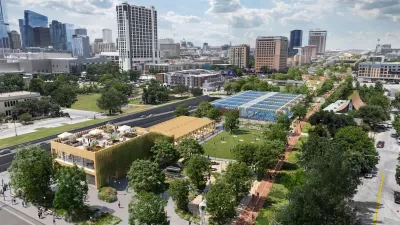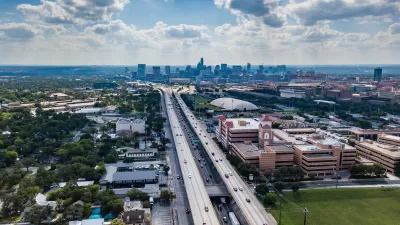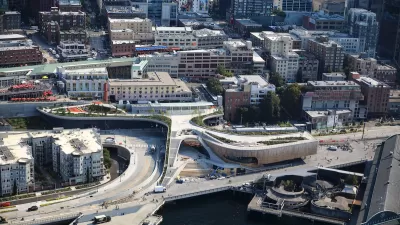The city’s plan includes parks, entertainment pavilions, commercial space, sports fields, and other facilities over 30 acres of deck parks spanning a sunken Interstate 35.

Newly revealed plans show Austin’s finalized vision for capping Interstate 35 after the Texas Department of Transportation lowers the main lanes below street level to accommodate deck parks.
Nathan Bernier describes the proposal, which includes a series of ‘caps and stitches,’ for KUT News. “Caps are more than 300 feet wide, and require advanced ventilation and fire suppression technology for the lanes below. Stitches are essentially caps that are less than 300 feet wide and don't require as much equipment.”
But don’t expect to walk around on top of I-35 anytime soon: “While the first cap could open as soon as 2032, a child born today would have graduated college by the time the plans depicted below are fully constructed,” Bernier notes. (See the source article for images.) Funding for the full project also remains unclear, although it has received some federal grants.
Bernier provides a walkthrough of the plans, outlining the key elements of each portion of the project. “Austin has to prove to TxDOT that it's serious about the capping project. The city must pay the state $19 million by the end of the year to finish engineering designs for the base caps. Local officials must also present TxDOT with a funding plan that shows how the city will pay for everything.”
FULL STORY: Austin reveals most detailed plans yet for parks over I-35

Alabama: Trump Terminates Settlements for Black Communities Harmed By Raw Sewage
Trump deemed the landmark civil rights agreement “illegal DEI and environmental justice policy.”

Study: Maui’s Plan to Convert Vacation Rentals to Long-Term Housing Could Cause Nearly $1 Billion Economic Loss
The plan would reduce visitor accommodation by 25% resulting in 1,900 jobs lost.

Why Should We Subsidize Public Transportation?
Many public transit agencies face financial stress due to rising costs, declining fare revenue, and declining subsidies. Transit advocates must provide a strong business case for increasing public transit funding.

Paris Bike Boom Leads to Steep Drop in Air Pollution
The French city’s air quality has improved dramatically in the past 20 years, coinciding with a growth in cycling.

Why Housing Costs More to Build in California Than in Texas
Hard costs like labor and materials combined with ‘soft’ costs such as permitting make building in the San Francisco Bay Area almost three times as costly as in Texas cities.

San Diego County Sees a Rise in Urban Coyotes
San Diego County experiences a rise in urban coyotes, as sightings become prevalent throughout its urban neighbourhoods and surrounding areas.
Urban Design for Planners 1: Software Tools
This six-course series explores essential urban design concepts using open source software and equips planners with the tools they need to participate fully in the urban design process.
Planning for Universal Design
Learn the tools for implementing Universal Design in planning regulations.
Smith Gee Studio
Alamo Area Metropolitan Planning Organization
City of Santa Clarita
Institute for Housing and Urban Development Studies (IHS)
City of Grandview
Harvard GSD Executive Education
Toledo-Lucas County Plan Commissions
Salt Lake City
NYU Wagner Graduate School of Public Service





























